JEO 6 - SPACETIDE and FOSS4G Kansai 2025
A monthly news roundup plus some observations on the SPACETIDE and FOSS4G Kansai conferences.

Welcome to Japan Earth Observer (JEO), a free monthly newsletter with a news roundup and one in-depth article about the space, Earth observation and geospatial industries in Japan. In addition to a news roundup. I’m also going to write a bit about what I saw and heard at the recent Spacetide and FOSS4G Kansai conferences in July.
News & Announcements
💱 Contracts and Funding
- SpaceOne and SpaceBD have won a contract with the Japanese Ministry of Defense (JMoD) to launch an optical imaging satellite to be built by Canon. SpaceBD will provide launch services for a dedicated solid fuel Kairos rocket from SpaceOne. SpaceOne has yet to get a Kairos into orbit, so it is unsurprising that the announcement did not arrive with an estimated launch date.
- IHI Aerospace and ICEYE have signed an MOU to co-develop a SAR satellite constellation [Via Satellite] of up to 24 satellites to be manufactured in Japan. This is just an MOU and is subject to government approvals, but it is clearly aimed at Japan’s national security needs. Last month, I wrote about a new national security SAR constellation that JMoD wants to have built, and it’s possible this agreement is aimed at enabling ICEYE and IHI to create a viable team to pursue that contract. Otherwise, it’s not clear to me that Japan needs a third SAR constellation (after Synspective and iQPS).
- ispace Europe has won an extension to its existing Mission for Advanced Geophysics and Polar Ice Exploration (MAGPIE) contract with ESA [ispace], bringing the contract total to JPY 437 million (~ US $2.9 million). ispace is leading a consortium of European organizations aimed at exploring and characterizing volatile deposits in lunar polar regions as well as searching for water ice. This is still a “pre-Phase A” contract, so it remains early days, but it will help Europe begin to build a lunar exploration program.
- New Energy and Industrial Technology Development Organization (NEDO) (新エネルギー・産業技術総合開発機構) announced a NEDO Challenge for Satellite Data and is now accepting entries. The challenge offers up to JPY 50 million (~US $345,000) for innovative solutions that apply satellite data to the agriculture, forestry and fisheries industries.
- NEDO has also announced a second NEDO Challenge called the Generative AI Accelerator Challenge (GENIAC) Prize that will offer up to JPY 800 million (~US $5.5 million) to apply generative AI to private sector (manufacturing and customer support), public sector (improving processes in government agencies), and generative AI safety.
- Frontier Innovations Fund announced investments in two startups, Letara and Musashi Sky Plus. Letara is a startup spun out of Hokkaido University and is developing hybrid chemical propulsion for spacecraft. Musashi Sky Plus is a JAXA startup developing fixed wing unmanned aerial vehicles (UAVs) for security, disaster response, and logistics.
- Synspective has announced that they are going to be a distributor for Daichi-4 (ALOS-4) PALSAR data. By my count, that is the third company JAXA has selected to provide ALOS-4 data, the other two being PASCO, announced in January [SatNews], and Tenchijin, announced in April [Taiwan News].
🛰️ Technology and Infrastructure
-
Tokyo Metropolitan Government is sponsoring an Open Data Hackathon aimed at encouraging use of its open data resources to create innovative services, visualizations, and idea proposals. Teams can apply until July 25 and top teams will be selected between August and October. Winning teams will be provided with support to develop and test prototypes with successful prototypes released at a Demo Day in March 2026. Submitted projects need to leverage open data resources available in the Tokyo Metro government’s impressive open data catalog. In a Japan-specific twist, in addition to excluding socially inappropriate businesses, like gambling, entertainment, and multi-level marketing, organized crime groups (暴力団), their employees, and members are explicitly excluded from participation. So Yakuza members with a passion for civic tech and open data will have to sit this one out.
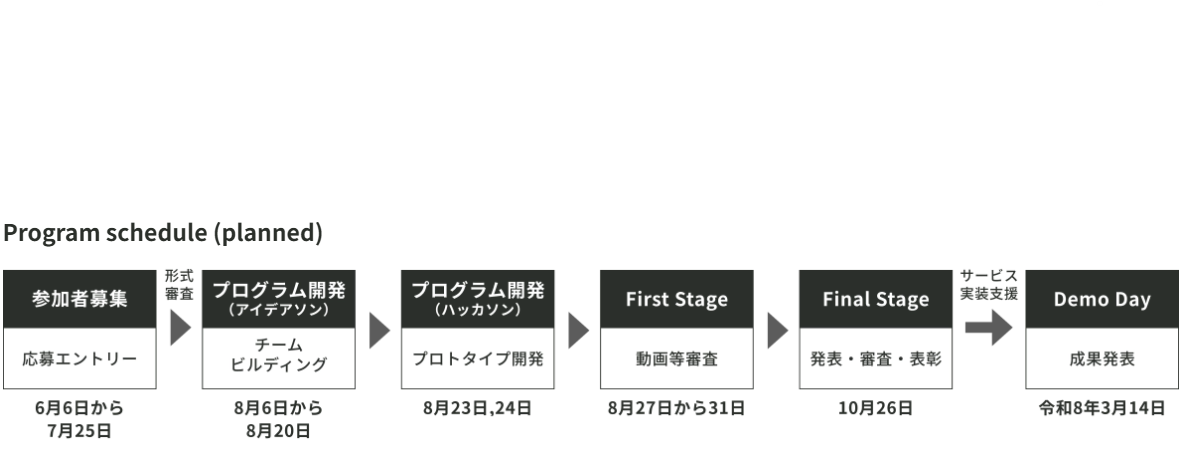
Tokyo Open Data Hackathon schedule -
ispace Hakuto-R lunar mission to land in Mare Frigoris ended in failure on Thursday 5 June. The telemetry went dark at 1 min 45 sec before it was supposed to land. In a Friday press conference, the company acknowledged the failed landing, but stated that it will take time to determine the root cause. The landing effort was broadcast live on YouTube [Japanese] [English broadcast]. A few observations and additional details from the live show:
- ispace really played up the “Resilience” nickname for the lander and the “Tenacious” nickname for the micro-rover (月面探査車) and how this resilience theme applies to everything the company does. There was also a general acceptance that this second lunar landing attempt by ispace may not succeed, and if that is the case, they will move on to the next lander.
- ispace really emphasized that it is a global company. It was notable how many people in the Mission Control Center (MCC) and other elements of the company are from non-Japanese nationalities.
- To highlight the distributed nature of the effort, the broadcast also included live feeds from teams and partners in Luxembourg, Washington DC, and Denver.
- The message from the U.S. Ambassador to Japan, George Glass, highlighted the decades of collaboration in space exploration between Japan and the United States, but his “learning, building, and dreaming together” message also felt a bit incongruous in the context of the ongoing aggressive tariffs levied on Japan by the U.S.
- In addition to the lander and micro-rover, there are other experiments on the mission:
- Water electrolyzer (月面用水電解装置) prototype developed by Takasago Thermal Engineering
- Deep Space Radiation Probe (深宇宙放射線プローブ) developed by Taiwan National Central University
- LunaGlena Algae-based Food Production Experiment (藻類培養実験) developed by Euglena
- GOI “Space Century Chapter” commemorative plate (GOI 宇宙世紀憲章プレート) by Bandai Namco - it’s reference to the Gundam franchise
- “The Moonhouse” (モーンハウス) sculpture by Swedish artist Mikael Genberg [YouTube] will be deposited on the moon by the Tenacious rover, if all goes to plan.
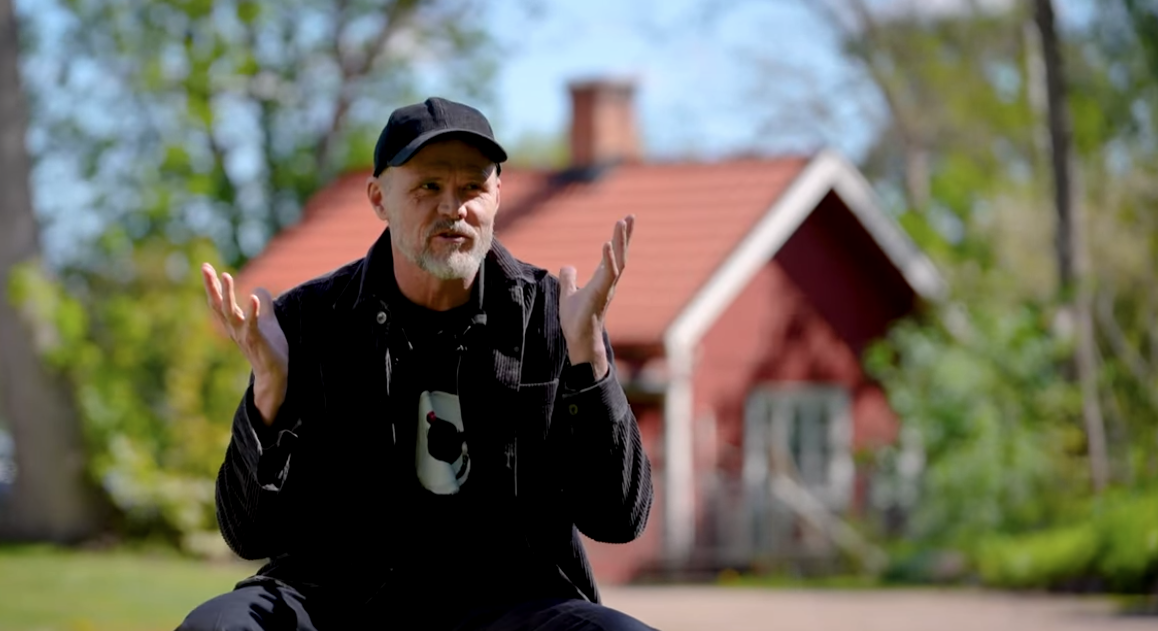
Artist Mikael Genberg explaining his sculpture in front of an iconic Swedish home.
-
Logos of customers and partners were prominent on the satellite and on everyone’s mission jackets; I think it’s possible that the patches weigh more than jackets.
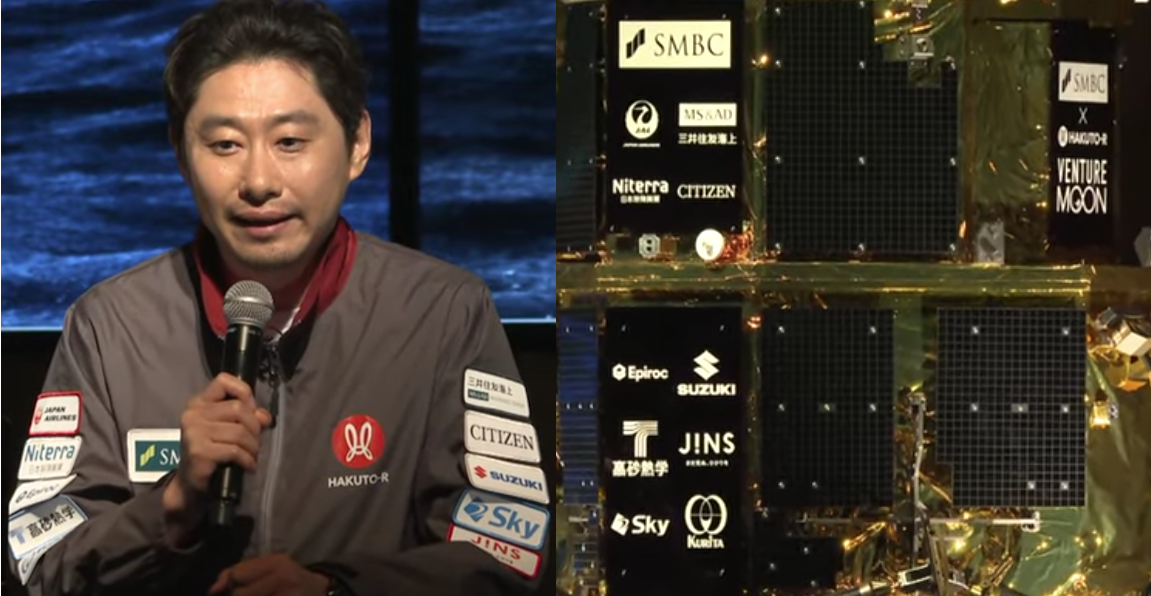
Customer and sponsor logos get top-billing on both the lander and the team outfits. -
I thought the live broadcast did a good job of explaining the mission, introducing the various components and partners as well as providing a live feed of the lander status. SpaceX has really pioneered the live rocket launch video feed and dashboard, and ispace had a comparably good set of graphics on its mission status dashboard.
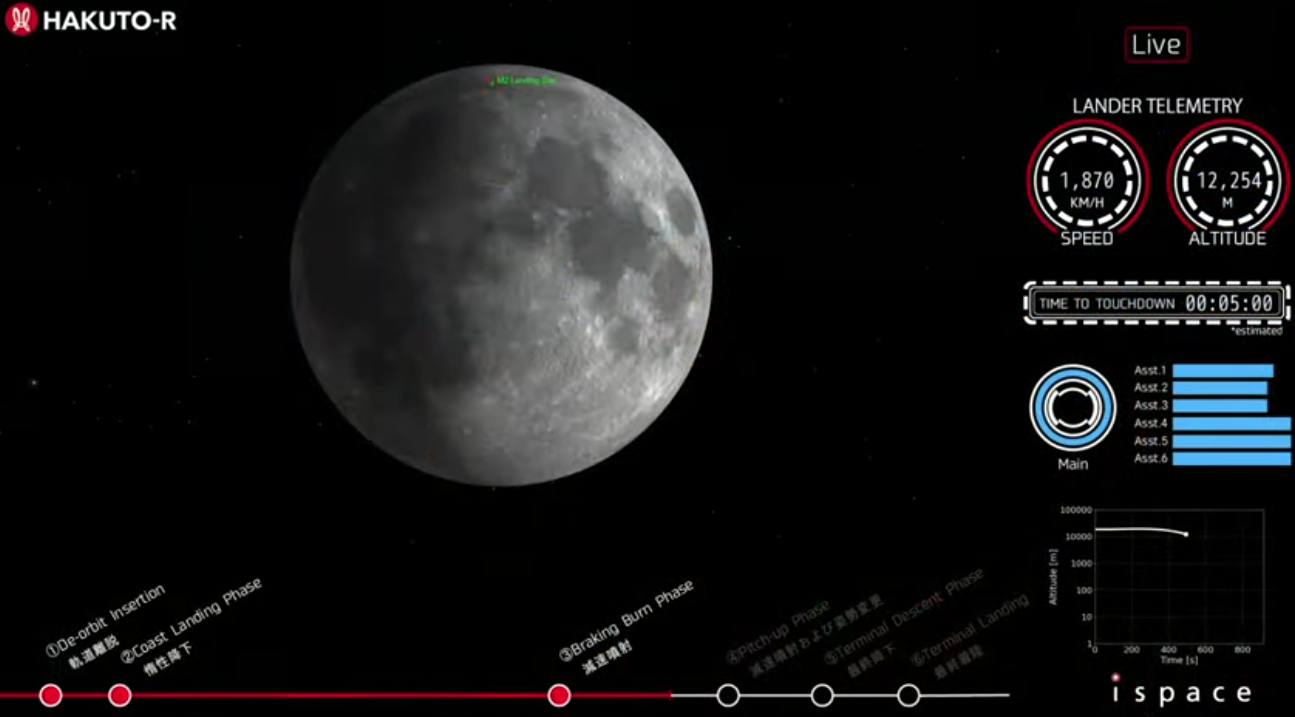
Hakuto-R lunar landing telemetry live dashboard. Credit: ispace -
The U.S. subsidiary of ispace will have to delay launch of its Apex 1.0 lunar lander [SpaceNews] from 2026 to 2027 due to engine development timeline issues. The lander is being developed with Draper for a mission funded by NASA’s Commercial Lunar Payload Services (CLPS) program. The lander engine was originally going to be the A2200 from Agile Space Industries. The A2200 will be replaced by VoidRunner, an engine to be jointly developed by ispace and Agile. The replacement engine will have dramatically fewer parts and enable a simpler vehicle design, but the change to such a fundamental component will require redesign of the lander. Once launched, the lander will attempt to land at Schrödinger Basin on the far side of the moon after putting two communications relay satellites into orbit: Alpine and Lupine.
-
RocketLab launched another SAR satellite [SpaceNews] for iQPS on 17 May from its New Zealand launch complex to a 575km, 42° mid-inclination orbit. iQPS is aiming to build out a 24-satellite constellation by 2027 and has booked four more launches in 2025 and two in 2026.
-
Astroscale completed a critical design review (CDR) milestone under the ELSA-M contract [SpaceNews] with the UK Space Agency to deorbit a defunct OneWeb satellite. The next steps will be assembly, integration, and testing of the actual servicing satellite, which will be designed to potentially remove multiple satellites from orbit by attaching to a magnetic docking plate and then releasing the dead satellites into a path that will burn them up in the atmosphere. While Astroscale has a contract with the UK to support this active debris removal (ADR) mission, it is actually paying for most of the work itself in the hopes that it will lead to additional contracts in the UK and a full commercial service in the future.
-
Astroscale has announced an R&D collaboration with Honda to jointly develop a satellite refueling port connection system [Astroscale] in order to support in-orbit refueling services that can extend the lifespan of satellites. The work will be funded by a “K Program” award from the Cabinet Office.
-
Synspective has released a new object detection and classification solution [Synspective] in collaboration with Polish firm, SATIM. The solution is now integrated into Synspective's analytics platform and is specifically focused on monitoring aircraft and shipping vessels, with plans to extend detection to a broader range of objects. SATIM has a lot of expertise using AI and SAR data for Automatic Target Recognition (ATR), and they already work with other SAR satellite constellations like Umbra, Capella, and ICEYE as well as European defense firms, Airbus and Thales. I wonder if this will provide exclusive access to the Japanese market for SATIM’s technology or if there is room for competitor iQPS to sign a similar partnership agreement. Some EO companies have a clear strategy of focusing on collecting and delivering data and relying on their partners to build software solutions like this one; Umbra sticks to its data collection knitting and is an example of this approach. Others EO firms, like Capella and ICEYE, have developed software solutions that they sell alongside their data. Synspective is clearly headed down this latter path, and it already provides other solutions, like land displacement monitoring, disaster damage assessment, and forest inventory management. iQPS does not list any solutions, and I wonder if this is a strategic decision, like Umbra's, to focus on data.
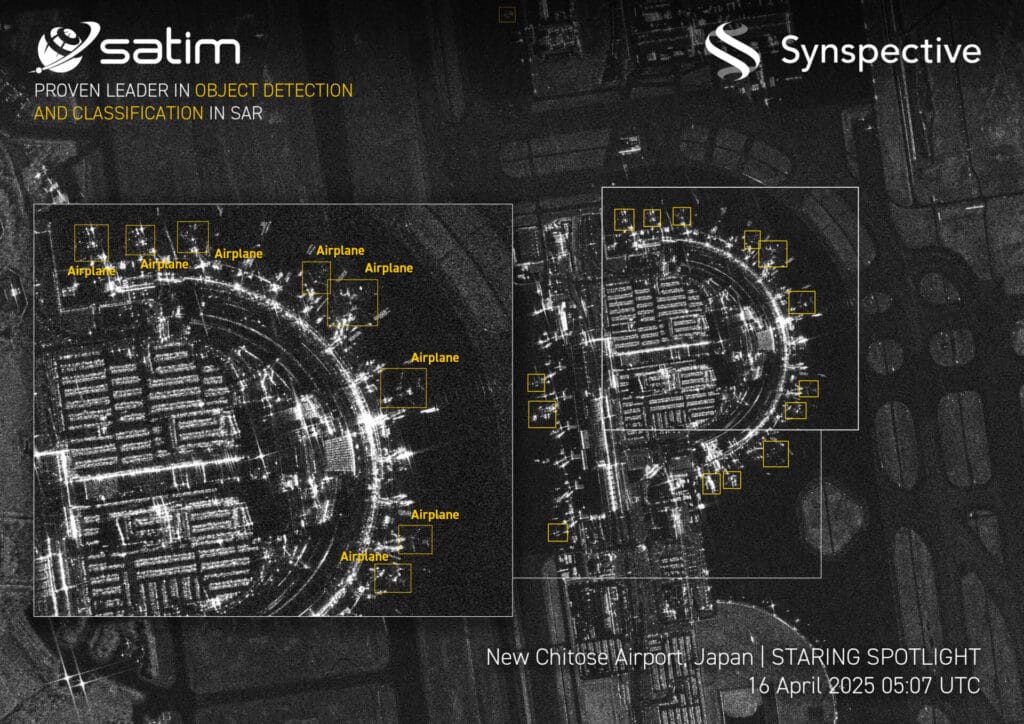
Synspective SAR image for New Chitose Airport with airplanes highlighted. Credit: Synspective
🔭 Science
-
NTT Space Environment and Energy Labs has successfully tested using AI and a drone to actively trigger lightning [Science Alert], transfer the energy to the ground, and still survive the strike. The AI model is trained on atmosphere electric field data and can forecast both potential lightning strike locations and charge distribution across a region. The drone is encased in a metal Faraday cage, which diverts the electricity around the drone and into wire. NTT’s goals are to both reduce damage from lightning strikes and provide a new power source, though the technology to absorb a vast, instantaneous spike of power and then filter it into the electrical grid does not yet exist.
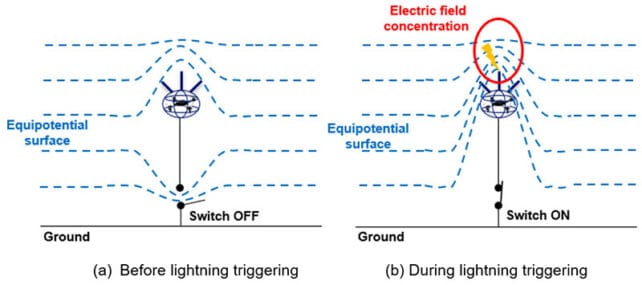
Diagram of electric field and lightning triggering concept. Credit: NTT Group -
JAXA is developing a more sophisticated model for assessing earthquake damage [Asahi] on a building-by-building basis. The model is being trained using detailed building damage data from the twin Kumamoto earthquakes in 2016. After the earthquakes, local authorities carried out detailed assessments of the impact on each building. This local data is being combined with synthetic aperture radar (SAR) images from the ALOS-2 (aka Daichi-2 or だいち2号機) satellite. SAR sensors can capture images in both day and night, regardless of cloud cover and are capable of detecting vertical elevation change as small as a few centimeters. The new model is expected to be able to deliver rapid damage assessment after an earthquake using both ALOS-2 and the newer ALOS-4 satellites.
-
JAXA and the National Institute of Advanced Industrial Science and Technology (AIST) are building a new foundation AI model using Daichi-2 PALSAR-2 synthetic aperture radar (SAR) data and adapted to the conditions of the Japanese archipelago. The aim is to lower the barriers to using SAR data.
-
The extended Hayabusa 2 asteroid mission is back on track. After going into safe mode in March, JAXA determined that it was due to temporary failure in one of four reaction wheels (RW) used to control attitude. The reaction wheels all appear to be working again and the JAXA announced via X on 29 May that the ion engine had been turned back on. After visiting asteroid Ryugu (竜宮) in 2018 and returning samples back to the Earth in December 2020, it is currently on its way to a second asteroid, 1998 KY26 (Torifune トリフネ).
🗺️ International Collaborations
-
JAXA ALOS-2 PALSAR-2 Level 1 ScanSAR data is now available through the NASA Alaska Satellite Facility Distributed Active Archive Center (ASF DAAC) and, more generally, through NASA Earthdata search. I will write in more detail about Japan’s open data policies below, but I think this is kind of a big deal. ALOS-2 data has been available from commercial data providers in Japan and some data products are available on Google Earth, but general availability to the world’s scientists has been limited. ALOS-2 has been in orbit since 2014 and its imagery is especially useful for landscape topography, ice sheet changes, vegetation analysis, erosion/ground deformation, and disaster response. Further, while commercial SAR constellations capture short wavelength X-band radar data (~3cm), which is useful for high resolution monitoring of urban areas, infrastructure, and surface change detection, L-band radar has longer wavelengths (~24cm) and is capable of greater penetration through vegetation and subsurface soil. ALOS-2’s L-band imagery is both useful in its own right and complements forthcoming science missions, like the NASA/Indian Space Research Organization (ISRO) SAR (NISAR) mission. I found it really interesting to learn that this data partnership has been almost two decades in the making. ALOS-1 had a small data recorder that required frequent downlink in order to free up memory for new observations. JAXA created an agreement with the Alaska AF facility to downlink the ALOS-1 data every time it passed over Alaska and then became the archive and distributor for North and South America data it received. Over the years, when scientists requested ALOS-1 data, it was added to the ASF archive. According to ASF DAAC Deputy Manager Kirk Hogenson. “Today, ALOS-1 is ASF’s most popular dataset.” This is a great example of how we can share resources and be better together.

Different ranges of SAR bands. Source: NASA
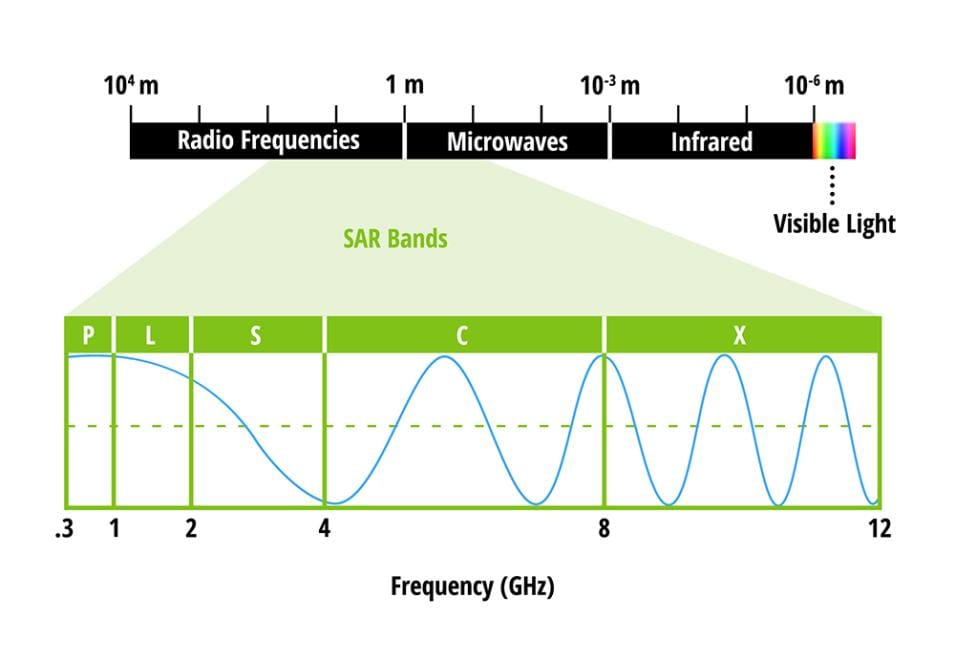
Sensitivity of SAR measurements to forest structure and penetration into the canopy at different wavelengths. Source: NASA -
JAXA will adapt if the Trump administration plans to radically cut the NASA lunar exploration and Earth science budget going forward. The NASA-led effort to return humans to the moon includes a Lunar Gateway space station, SLS rocket, Orion capsule and other U.S.-built components, but it also relies on key contributions from Japan, the European Space Agency, and Canada. The Trump administration’s proposed FY2026 NASA budget would cut the Lunar Gateway and SLS rockets after the third launch. However, the proposed cuts by the White House can easily be ignored by Congress, so the direction will likely not be clear until Congress sets the FY2026 budget due by October 2025. Depending on how it plays out, partners and suppliers may need to scramble to adapt [SpaceNews].
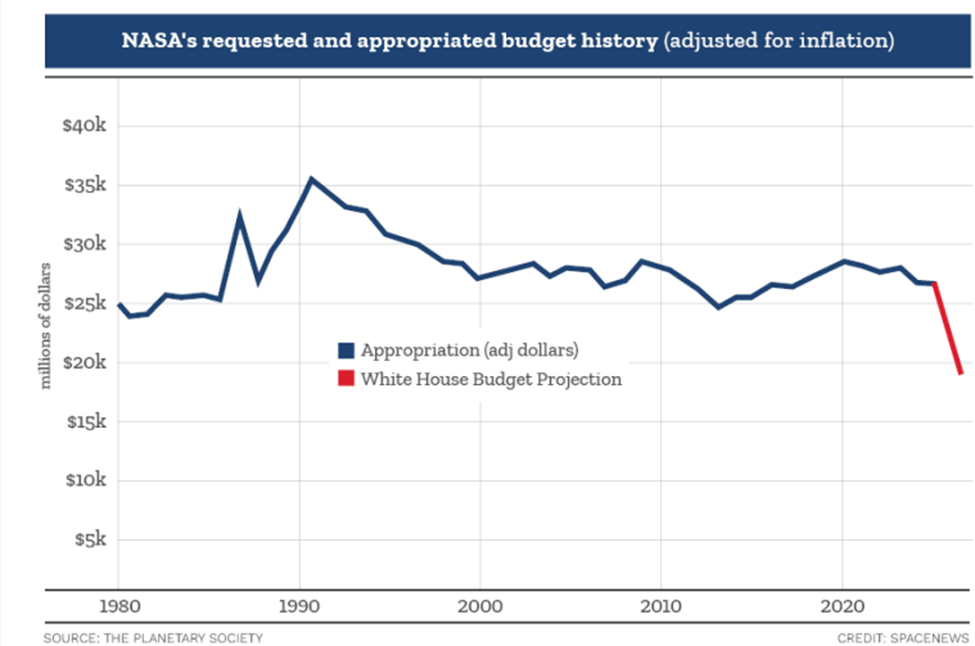
NASA inflation-adjusted budget since 1980 with FY2026 budget proposal. Source; SpaceNews
📆 Asia-Pacific Conferences & Events
This newsletter is mostly focused on Japan, but I also like to highlight events across the Asia-Pacific region. Some upcoming conferences in 2025 include:
Aug 2025
- Binary Stars in a New Era - 24 - 30 Aug - Lijiang, China
Sept 2025
- 26th Advanced Maui Optical and Space (AMOS) Technologies Conference - 16 - 19 Sept - Wailea, HI, United States
- AstroEdu Conference - 23 - 25 Sept - Melbourne, Australia
- Aeromart Nagoya - 24 - 26 Sept - Nagoya, Aichi, Japan
- Space Generation Congress (SGC) - 25 - 27 Sept - Sydney, Australia
- FOSS4G Hokkaido 2025 - 26 - 27 Sept, Sapporo, Japan
- Deep Space: To the Moon and Beyond - 12 July - 28 Sept 2025, Miraikan, Tokyo, Japan
- Space Suppliers Summit Nagoya - 26 - 28 Sept - Nagoya, Aichi, Japan
- 32nd IAF Workshop – Resilient Coasts, Resilient Earth - 26 - 28 Sept - Sydney, Australia
- International Astronautical Congress (IAC) - 29 Sept - 3 Oct - Sydney, Australia
Oct 2025
- Space-Ship 2025 (Cruise) - 5 - 9 Oct - Sydney, Australia
- Asia-Pacific Conference on Synthetic Aperture Radar (APSAR) - 5 - 9 Oct - Matsue, Shimane, Japan
- New Zealand Aerospace Summit - 7 - 8 Oct - Christchurch, New Zealand
- FOSS4G 2025 Japan - 11 - 12 Oct - Senshu University, Kawasaki, Japan
- Thailand Space Expo - 16 - 18 Oct - Bangkok, Thailand
- Seoul Aerospace and Defense Expo (ADEX) - 21 - 25 Oct - Seoul, South Korea
- Asia-Pacific International Symposium on Aerospace Technology - 27 - 29 Oct - Seoul, South Korea
- International Congress of Aviation and Space Medicine (ICASM) - 27 - 30 Oct - Singapore
- International Symposium on Antennas and Propagation (ISAP) - 27 - 31 Oct - Fukuoka, Japan
- Nihonbashi Space Week - 28 - 31 Oct - Nihonbashi, Tokyo, Japan
- 19th Annual Meeting of International Committee on Global Navigation Satellite Systems (ICG) - 19 - 24 Oct - South Korea
Nov 2025
- Asia-Pacific Satellite and Space Community Conference (APSCC) - 4 - 6 Nov - Taipei, Taiwan
- Free and Open Source for Geospatial (FOSS4G) - 17 - 23 Nov - Auckland, New Zealand
- Asia-Pacific Regional Space Agency Forum (APRSAF) - 18 - 21 Nov - Cebu Island, Philippines
- 69th Space Science and Technology Conference (宇宙科学技術連合講演会) - 25 - 28 Nov - Sapporo, Japan
- FOSS4G Shinshu 2025 - 29 - 30 Nov - Shinshu University, Ina, Nagano, Japan
Plus some recent events available on YouTube:
- JAXA GOSAT-GW Press Conference - 20 May 2025
- JAXA astronaut Kimiya Yui Press Conference regarding long-term stay on the ISS and activities on the Japanese "Kibo" module during his stay - 4 June 2025
- ispace Hakuto-R moon landing livestream - 5 June 2025 - English | Japanese
- H-IIA No. 50 launch of GOSAT-GW from Tanegashima Space Center - 29 June 2025
SPACETIDE and FOSS4G Kansai 2025
I was recently in Japan to attend some conferences, see the sites, and connect with friends. The conferences, in particular, were all related to geospatial, space, and remote sensing, and I thought it might be helpful to share a few observations.
SPACETIDE 2025
SPACETIDE was the main event that drew me to Tokyo in mid-July. I attended in 2024 as well, so I had a sense of what to expect, but this was a milestone year: the 10th anniversary of the event. Since it got started in 2015, SPACETIDE has focused on the commercial space industry. In that relatively short time, the industry has grown substantially and is now considered a strategic priority for investment and labor market growth by the Japanese government. This year, the conference attracted 2,000 people from more than 35 countries. I think the organizers probably boosted that attendance by hosting a parallel event in the same venue, Space2Earth Asia Summit, organized by Geospatial World, a geospatial media and events company based in India. In addition, there were several side events held in a nearby venue and hosted by Secure World Foundation, Cambridge Consultants, Swedish Space Corporation, the European Space Policy Institute (ESPI), and others.
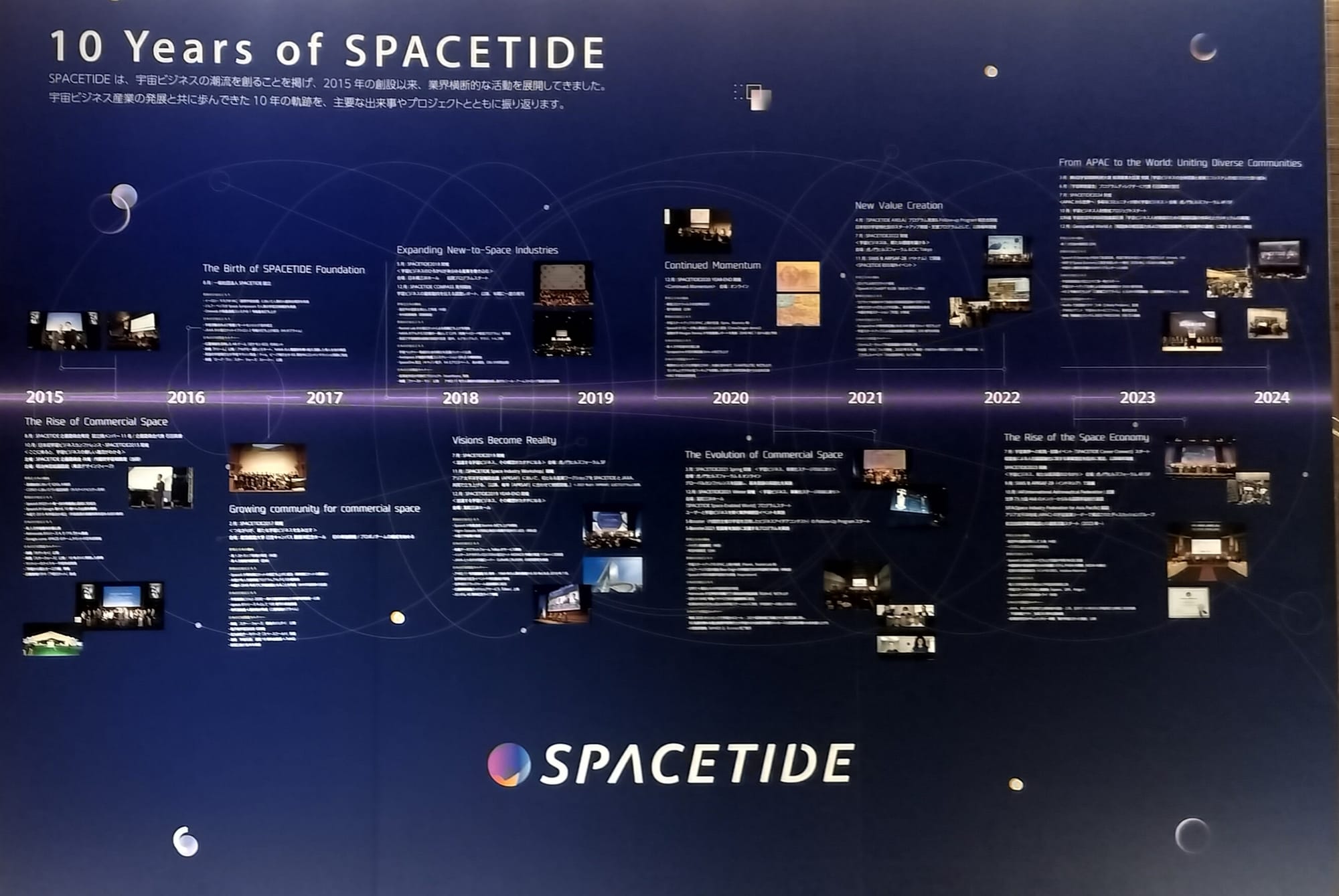
10 years of SPACETIDE. Credit: Spacetie Foundation
I think this conference is interesting for several reasons. First, the event has grown to attract people from across the Asia-Pacific region as well as a smattering of folks from Europe and North America. The organizers seem to be well connected and have substantial convening power: most of the speakers were senior executives in government, commercial, and nonprofit organizations. The event has high production values and all sessions are presented in both English and Japanese with either simultaneous translation or on-screen transcription. Many conferences held in Japan will obviously rely primarily on the Japanese language. This one is different and, as such, it is quite accessible for anyone with reasonably good English language skills.
Memorable Talks
There were three tracks through most of the conference, so I missed most of the talks, but of the subset I saw, a few stood out. The first day of the event was mostly marked by a succession of anodyne welcoming remarks, but one talk in the late afternoon was different. The President of Honda R&D, Ohtsu Keiji, gave an insightful and substantive introduction to both Honda’s philosophy and mission and why Honda sees the space sector as an opportunity for significant investment and growth. In June Honda took a lot of people by surprise with the successful launch and landing of a reusable rocket prototype. Honda’s core business is manufacturing 2- and 4-wheel vehicles and other engine products. Ohtsu outlined how their space-related R&D is a natural outgrowth of their automobile and engine technology. First, the Honda Fuel Cell system has been under development for 30 years to support hybrid and electric vehicle engines. The latest version will be tested on the ISS in 2027 with an eye to use on the lunar surface for water electrolysis into hydrogen and oxygen. Second, while Honda’s robotics work is probably associated in the popular imagination with the discontinued Aibo robotic dog, they have continued to invest in robotics technology, and are now developing “avatar” robots that support remote operation and “shared autonomy”. Again, this has applications for on-orbit robotics and lunar operations. Finally, the rocket project grew out of combustion experiments for ground vehicles. Honda plans to continue developing the rocket and is aiming for sub-orbital tests by 2029.

Honda’s regenerative fuel cell system can operate without a compressor. Credit: Honda R&D
Other notable talks the first day were from Sir Peter Becker, Founder and CEO of RockerLab and Lisa Campbell, President of the Canadian Space Agency. Becker spoke about his company’s experience working with the Japanese space industry. He also highlighted 1) the supply chain challenges of building complex manufactured products at scale and how this led to a highly vertically integrated company that makes most of its own components; 2) a strong appetite for commercial capabilities on the part of governments; and 3) rapidly growing defense demand. Cambell highlighted almost four decades of science and space collaboration between Canada and Japan with many concrete examples of bilateral cooperation on Earth observation, disaster response, and technology development. She also highlighted their shared vision for peaceful space exploration and what Canada can learn from Japan. This contrasted with a Day 3 talk by George Glass, the U.S. Ambassador to Japan, who focused solely on United States accomplishments and barely mentioned shared endeavors with Japan. It came across as tone-deaf and arrogant to me.
Some other memorable takeaways:
- Chris Spagnoletti (Ursa Major) announced a partnership with Innovative Space Carrier and observed that Japanese companies all seem to assume a government subsidy and the ease with which this can become both an addiction and impede commercial development.
- Suzuki Kazuto (University of Tokyo) spoke a few times and was always candid and insightful. He highlighted the lack of long-term security arrangements between the U.S. and Japan, and noted that while both Japan and the U.S. have export regimes, they are not well aligned. A new Technology Safeguards Agreement (not yet signed) and a new Japanese security clearance system for commercial firms may help to smooth future security-related collaboration, but it’s currently not a smooth collaboration. He also highlighted the relatively low risk tolerance of Japanese investors. This tends to generate a similar risk stance among Japanese companies, and by being exposed to a more international investment community, Japanese firms are more likely to be able to move with greater speed, agility, and tolerance for risk. In a side event organized by ESPI, Suzuki also had a blunt assessment of the impact the Trump administration is having on the U.S.-Japan relationship:
- The U.S. is no longer seen as a reliable partner.
- The withdrawal of the Isaacman nomination as NASA Administrator and the lack of commitment to the Lunar Gateway and other joint projects has deepened the sense of uncertainty.
- Japan will be forced to learn more tolerance of volatility in the U.S. relationship.
- The focus on Mars for human spaceflight by the U.S. is not shared by Japan, which is more interested in lunar exploration.
- We are all underestimating the impact of supply chain disruptions being created by tariffs and other trade tension.
- Blaine Curcio (China Space Monitor) gave a great overview of the investment and space industry landscape in China with particular focus on municipal and provincial governments as the key source of funding an extremely fragmented commercial ecosystem.
- Amaki Daiki (Development Bank of Japan - 日本政策投資銀行) noted that his team has reoriented from seed stage to growth stage investments over the past three years because there are both more early stage private investors in Japan today and new debt and capital financing is more available. He also noted that, compared to ten years ago, Japanese space companies are much more open to partnering with non-Japanese firms across Europe, Middle East, Asia-Pacific, and North America.
- Simon Potter (Bryce Space Global) noted that over the past decade, defense investment has been perceived as antithetical to environment and sustainability concerns, but that this is now being reassessed by both companies and investors. He also pointed out that some recent contracts between European countries and U.S. firms have been driven by a sense of urgency, but that over time these governments are likely to shift spending to European firms as their capabilities improve. Finally, he pointed to the relatively new NATO Investment Fund as actively investing in space companies.
- Mori Hazuki (World Economic Forum) highlighted the manufacturing supply chain disruption of both tariffs and yen exchange rate volatility. She also noted that a perceived retreat by the United States is drawing in a range of new actors attempting to fill the leadership vacuum.
- Clayton Swope (CSIS) noted that if this conference were in the U.S. every other talk would have mentioned China, but it has barely been mentioned all week. He observed that during the Cold War, the U.S. and the Soviet Union developed an “Incidents at Sea” agreement that set rules and norms for encounters by ships in order to reduce the risk of misunderstanding. We do not have an equivalent agreement that would set norms and rules for space. Satellites and other spacecraft are increasingly maneuverable, increasing the risk of misunderstanding and escalation.
- Marc Prioleau (Overture Maps Foundation) made the case for both private sector investment and openly licensed data as a foundation for global geographic data collaboration.
- John Lee (KASA) described South Korea’s key focus as developing domestic sovereign capacity for launch, satellite, imaging, and positioning.
- Bill Chang (HelioX Cosmos) stated that every company in Taiwan shares a mission to integrate with the wider world. He also noted a talent shortage in Taiwan that is similar to those faced by Japan and South Korea.
- Naga Bharath Daka (Skyroot Aerospace) made a case for an affordable, reliable, on-demand series of VIKRAM rockets for a range of satellite sizes. Similar to Japan, India faces a dearth of large funds that can support growth stages, forcing them to look to Singapore, North America, and Europe for growth capital. However, unlike Japan, India graduates a large number of qualified space scientists and engineers, but does not have enough jobs, so they end up leaving the industry.
- Robbie Schingler (Planet) described the two key enabling technologies for the coming decade as optical inter-satellite link and on-orbit data processing technology. He has a vision for future satellite architectures that will use open standards to enable interoperability between constellations.
- Kato Satoshi (Kokusai Kogyo 国際航業) participated in a panel in digital twins and noted some key challenges that will need to be overcome in order to make digital twins truly useful. These include difficulties combining multiple data sources with different levels of precision and the ability to effectively represent non-physical boundaries, such as airspace regulations and jurisdictional boundaries. He also expressed some prudent skepticism about the speed with which digital twins will achieve broad use in Japan, where legal responsibility for a mistake based on a decision made using a digital twin would carry significant financial and reputational consequences. He doesn’t believe we have the level of precision necessary to avoid these types of accidents yet.
- Joann Yap (HEO Space) introduced a very intriguing new service for “non-Earth imaging” (NEI) of satellites and other orbital objects that can provide critical data for debris management, removal, and design of future satellites. HEO both piggybacks its own instruments on other satellites and contracts with BlackSky to swivel the satellites from Earth to orbital observation while they are flying over oceans.
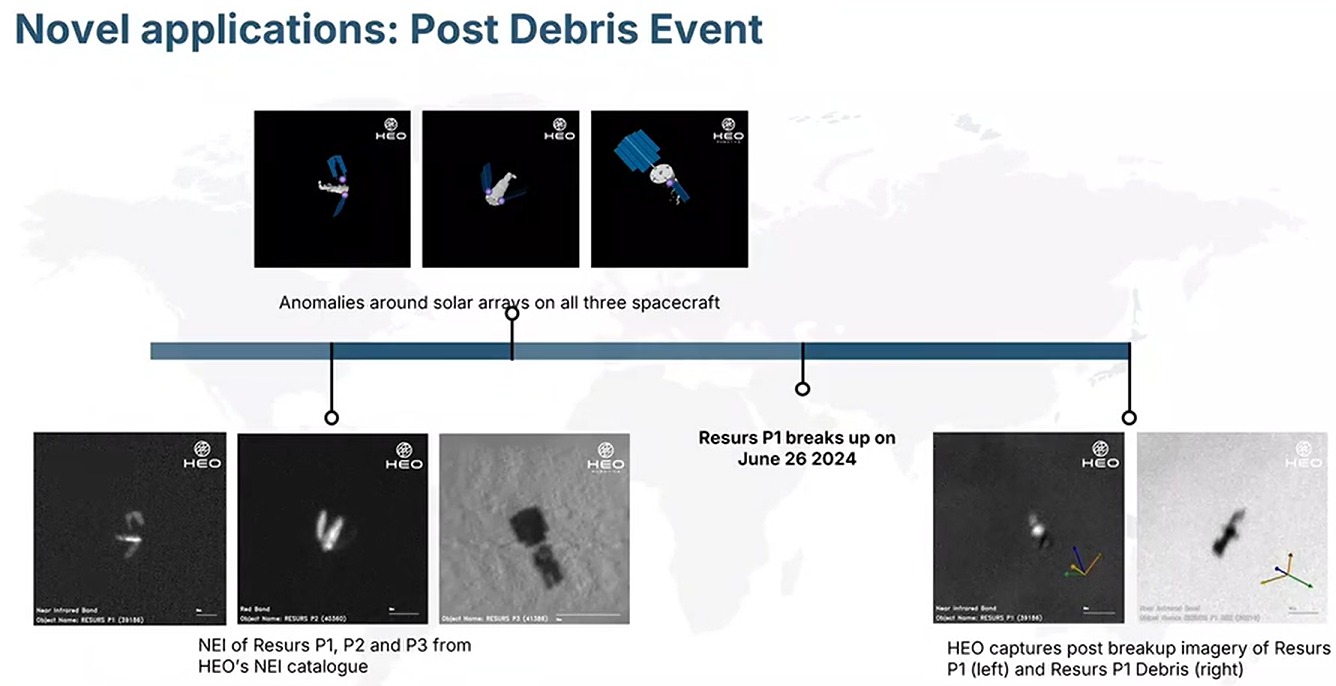
Visual evidence of Russian satellite breakup. Credit: HEO Space
General Observations and Impressions
Sponsors got value. If my company had been a sponsor, I think I would have felt like my sponsorship was worth it. Event sponsors got a fair amount of love with logo displays distributed throughout the venue, video loops between sessions, a special reception, reserved seating, presentation opportunities, and a busy exhibit hall.
Convening power attracts news and announcements. SPACETIDE impressively attracts a lot of senior executives from across government and commercial organizations. That makes this an attractive venue for announcing new deals. There were a bunch of them (and I missed several) including:
- AWS announced their new Asia-Pacific Accelerator Program
- Synspective announced their deal with Exolaunch
- Ursa Major and Innovative Space Carrier announced a partnership
Convening power has a downside. Most presenters were CEOs, Presidents, Executive Directors, heads of agencies, and other senior executives. That’s cool in the sense that you feel like “this is the place to be.” However, as a former CEO, I can attest that being a senior executive often means that you are constrained in terms of what you can say. Senior executives have a lot of stakeholders that they need to serve: employees, investors, customers, regulators, etc. This creates incentives to make statements that are safe, guarded, and anodyne. What does that mean? A lot of presentations and messaging is “oh, ok, that’s kind of obvious.” There were exceptions, but there were a lot of talks lacking courageous, opinionated, or just plain refreshing statements.
Relentless drumbeat of labor force shortages. Many Japanese speakers highlighted the challenge of recruiting qualified applicants as well as efforts to attract candidates from overseas and outside the industry. This is not unique to the space and geospatial sectors; Japan faces labor force shortages in retail, health care, logistics, transportation, construction, and a range of other industries. In parallel with the conference, SPACETIDE organized a Career Connect event in order to connect job seekers with companies.
Still a lotta man-els. There were a lot of “man-els” (all-male panels) and I served on one. The organizers probably deserve some credit for both having many speakers with diverse perspectives from across Asia, Europe, and North America as well as many women speakers. But it’s not enough, and it still needs work.
China was missing and it’s an opportunity. With the exception of Blaine Curcio, who writes the excellent China Space Monitor newsletter and offered some insightful observations on the China space sector, I did not see any presenters from China. This was despite several talks on Asia-Pacific topics that included speakers from Korea, Singapore, Taiwan, Australia, India, Malaysia, and Thailand. If this was the U.S, one might imagine that there were immigration visa issues, but that’s just not the case in Japan. Tokyo (and the rest of Japan) is inundated with tourists from China, and it is not hard to get to Japan from China. I suppose it is possible that Chinese business leaders in the space sector are not interested in attending SPACETIDE, but I am guessing that is also not the case. Clayton Swope’s observations (see above) resonate for me, and I think there is an opportunity here for Japan to demonstrate leadership by either engaging in or brokering a US-Japan-China collaboration in orbit. China is making extraordinary investments and technical advances in the space sector, and this creates a landscape for potential demonstrations of collaboration that can help defuse geopolitical tension. The SPACETIDE event coincided with the 50th anniversary of the Apollo-Soyuz mission in July 1975. I think there is an opportunity for similar sorts of symbolic collaborations today. The U.S., Japan, and Europe collaborate with China on air traffic management, meteorology, telecoms, and other sectors. Space should be similarly tractable. Maybe the opportunity is to collaborate on space traffic and debris management.
US tariffs and other behavior toward allies is rapidly undermining and eroding relationships. Few people said it out loud, but I walked away with a sense that whether commercial or government, folks across the Asia-Pacific are pivoting very hard to weave ties with other Asia-Pacific and European partners, and away from the United States. The U.S. remains an important market, but I think we can expect to see an Asia-Pacific region that is more integrated and independent from the U.S. in the years ahead.
Were you not able to attend SPACETIDE but wish you could have been there? The whole event was recorded on video, and you can still buy a video-only pass to view all tracks across the three days.
FOSS4G Kansai 2025
What is FOSS4G?
While I was in Japan in July, I attended another conference, FOSS4G Kansai, the weekend prior to SPACETIDE. This one was a much smaller, local, community event held at a local university in Osaka on a Saturday. “FOSS4G” stands for Free and Open Source for Geospatial and is the moniker used for regional, national, and international events organized under the aegis of Open Source Geospatial Foundation (OSGeo). As the name implies FOSS4G is a gathering of people who build geospatial software tooling that is released under open source licenses. While OSGeo hosts many open source software projects, talks and workshops at FOSS4G events can be on any topics related to open source software, open data, and open standards. The FOSS4G events are a chance for software developers, users, students, and business leaders in the geospatial technology industry to gather around a shared interest in building an open technology ecosystem. Most FOSS4G events have a common structure that includes four components: hands-on learning workshops, talks, social event(s), a poster or demonstration event, and some kind of hackathon or similar opportunity to build something together. FOSS4G Kansai was held over two days with Saturday being the “Core Day” with two tracks of talks, a poster session, and a dinner social event in the evening. I was not able to attend on Sunday, but the schedule included four half-day “Hands-on” workshops on various topics as well as a half-day “mystery” tour (なぞツアー) of the area.
There has been an international FOSS4G event held annually since 2004, and the event is organized in a different city each year. This year’s international FOSS4G event will be held in Auckland, New Zealand in November, and next year will be held in Hiroshima in August 2026. Regional FOSS4G events, such as FOSS4G Europe, FOSS4G Asia, and FOSS4G North America, are held on semi-regular schedules based on regional and national interest. Volunteers in Japan have been key contributors to both the establishment of OSGeo and the earliest FOSS4G events, and this community spirit is expressed in frequent national and regional FOSS4G events. The FOSS4G Kansai event was the first time of its kind in the Kansai region since the COVID pandemic, and it had the energy that arises from a gathering of old friends after a long absence.
If you are interested in a FOSS4G event in Japan this year, there are two more currently planned in the next few months:
- FOSS4G Hokkaido 2025 - 26 - 27 Sept, Sapporo, Japan
- FOSS4G 2025 Japan - 11 - 12 Oct - Senshu University, Kawasaki, Japan
Memorable Talks
FOSS4G Kansai had more than two dozen talks in two tracks, so I was not able to attend them all. As is the case for every FOSS4G event I have attended in the past, topics covered a broad range, from desktop and web software tools, like GRASS, GQIS, and MapLibre to technology implementation case studies and the latest in AI applications using the MCP standard. A few of the talks stood out for me:
Re:Earth. There were two talks on a new open source web application called Re:Earth, developed by Japanese software firm, Eukarya. The platform is now in an early alpha release, but the developers have outlined a platform designed for sharing, publishing, and visualizing urban data sets in 3D.

Re:Earth visualization of flood and landslide areas from Noto Peninsula Earthquake. Credit: Eukarya
Can OSS become a public good? Imamura Kazuki did a fascinating talk on a report her organization, Information-technology Promotion Agency (IPA) (独立行政法人情報処理推進機構), has released regarding Japan’s open source software promotion strategy. She outlined some major reasons that greater use of open source software would be in Japan’s strategic interest, as well as why IPA does not currently assess it as a sustainable community: there is no national open source strategy; there are only small numbers of open source contributors; and few companies have an open source usage policy, let alone an Open Source Program Office. In order to promote use of open source software and distribute better information, IPA has set up a new web site, Japan Open Source Hub.

Very few Japanese companies participate in the open source software community. Source: IPA
Cesium Developer Conference Report. Kukita Gen presented a quick overview of the first ever Cesium Developer Conference held in Philadelphia in June. This was of particular interest to me because I live in Philadelphia, I have followed Cesium’s development from its origins as an in-house open source project at AGI to its 2024 acquisition by Bentley Systems, and I attended the conference. Cesium began as an open source tool for displaying 3D geospatial data in a web browser. Despite taking on venture capital funding and recently being sold to Bentley, the Cesium javascript component remains available as open source software and Cesium continues to make significant contributions to open data and open standards development. Part of its commercial success has been based on close collaborative partnerships with leading companies in the Japanese Architecture, Engineering and Construction (AEC) sector. This first conference had more than 400 attendees from 30 countries, and almost 10% of the presentation sessions were by Japanese organizations, including Nippon Koei, CalTa, MRI, LocusBlue, Takram, and EARTHBRAIN. The EARTHBRAIN talk was particularly interesting. EARTHBRAIN is a joint venture by Komatsu, NTT, Sony Semiconductor, and Nomura Research Institute focused on construction equipment automation. In a collaboration with Cesium and Bentley, they have developed a data processing pipeline that enables them to rapidly integrate both initial data scans of large construction sites and update the resulting 3D model with scans of ongoing changes. Cesium had developed an open 3D data specification format, 3D Tiles, a decade ago. Cesium continues to make changes to improve on the 3D Tiles standard, and new version of this, called NextGen 3D Tiles, enables the EARTHBRAIN product to support “time-dynamic data” so that a single data store can support the thousands of surface changes that can occur at a large construction site over time.
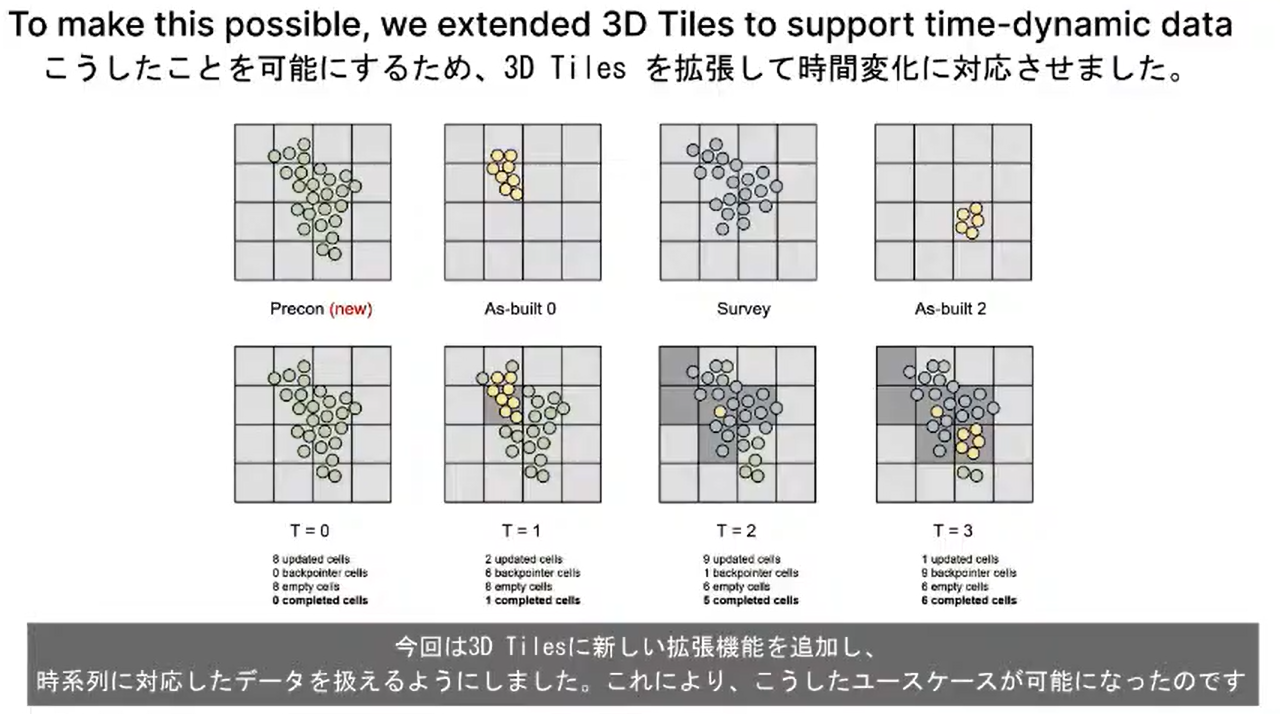
An overview of how time-dynamic data is made possible with 3D Tiles. Credit: EARTHBRAIN
An Introduction to the Overture Maps Foundation. Mori Toru gave an overview of the Overture Maps Foundation, a project based at the Linux Foundation. I am quite enthusiastic about the Overture initiative, and I was interested to see how it would be framed by Mori, a deeply knowledgeable and experienced geospatial expert. Overture aims to assemble the available data concerning the built environment (roads, buildings, etc.), organize it, integrate it, and share it under an open license. While less than three years old, the project has successfully released data on a regular cadence, has an Overture Maps Explorer for visualizing the current state of the data, and has developed a global entity reference system (GERS) that serves as a unique identifier for each feature. I agree with Mori that this latter innovation, the GERS ID, is perhaps the most important output of the effort. Combined with open source software tooling for conflating diverse data sets (removing duplicates, determining the best version, etc.), Overture is providing important infrastructure for every geospatial data user in the world by paying the “conflation tax” on behalf of everyone. Mori also highlighted where Overture comes up short. He showed basic errors in the location of major landmarks in Tokyo and Osaka. Mori also highlighted that while this is an open data and open source effort, it is currently primarily an industry alliance funded by four big tech companies. Successful open source and open data initiatives usually need to cultivate communities in order to be sustainable in the long run, and while there is the potential for Overture to build a community around its work, this remains nascent.
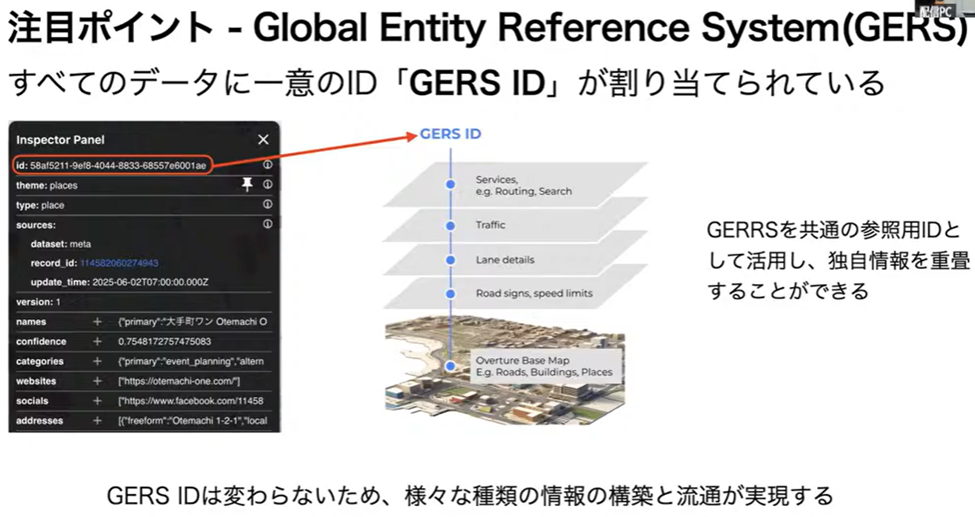
Overview of the GERS concept. Credit: Mori Toru and Overture Maps Foundation
Global FOSS4G 2026 in Hiroshima. The day concluded with some more details about the global FOSS4G conference planned for 30 Aug - 5 Sept 2026 in Hiroshima. Before talking about the 2026 event, Iwasaki Nobusuke (Tottori University) shared a helpful overview of the history and long-term relationship between the OSGeo Foundation and the Japan national chapter of OSGeo. Iwasaki also highlighted two upcoming regional FOSS4G events FOSS4G Hokkaido 26-27 Sept 2025, FOSS4G Japan 11-12 Oct 2025, and FOSS4G Shinshu 29-30 Nov 2025.
Aiming for 500 - 1000 attendees
Dinner social. There were also a few lightning talks at the evening dinner event, and I particularly enjoyed one on the geospatial coordinate and projection system in Japan, despite the projection on a wood paneled wall.
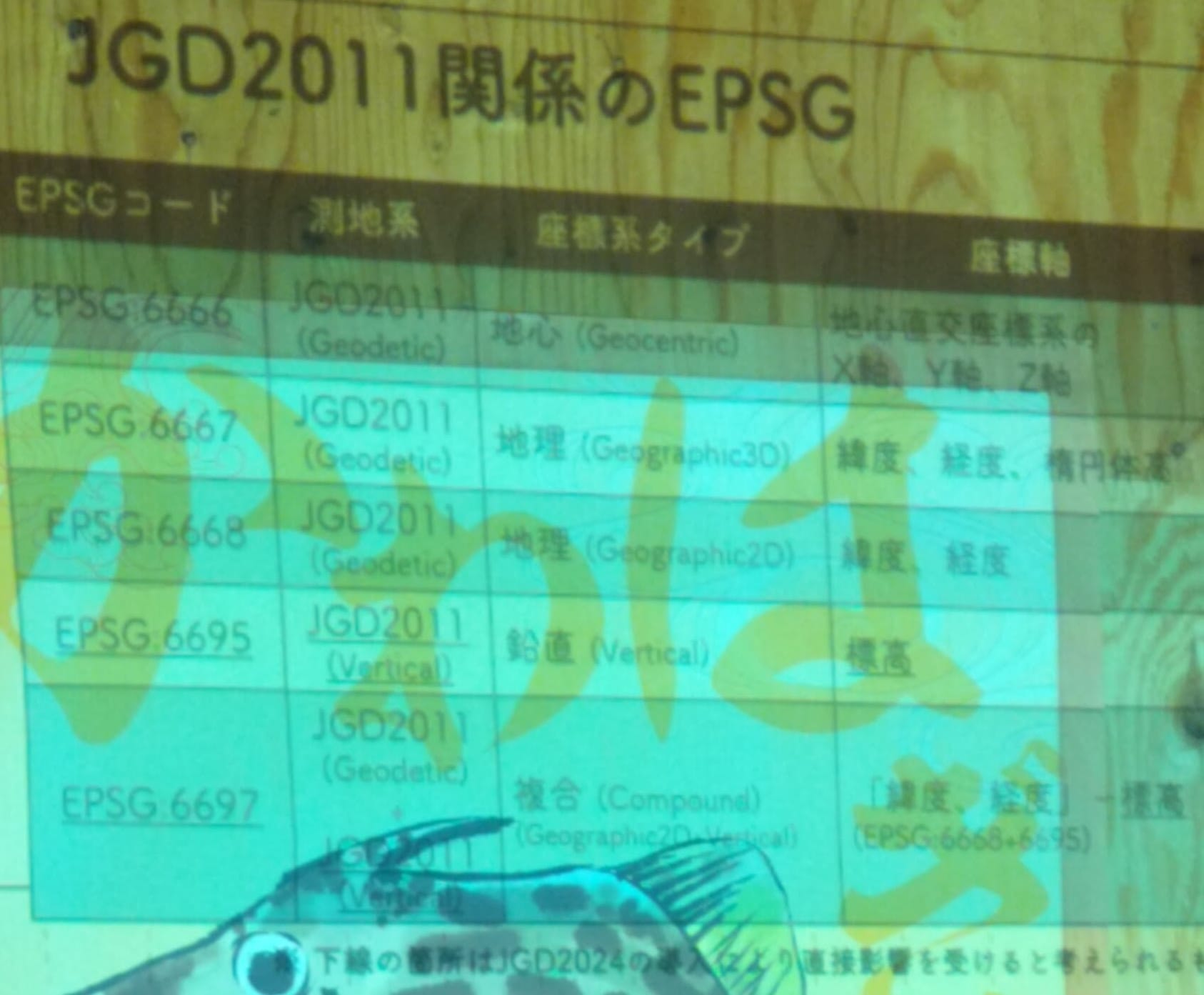
A summary of EPSG codes related to the 2011 Japan Geographic Datums.
General Observations
Rasters vs. Vectors. Over the past several years, I have observed a significant increase in FOSS4G talks focused on processing and using raster data (imagery and other gridded data) and related tooling and standards - Rasterio, GDAL, STAC, COGs, ZARR, Icechunk, etc. - as well as 3D and point cloud data (PDAL, Cesium, etc.). I think this reflects a significant increase in the availability and application of drone and satellite Earth observation data. It may not be fair to generalize from a one-day regional event, but the FOSS4G Kansai talks reflected more of an interest in a mix of desktop and web GIS tooling - QGIS, GRASS, MapLibre, etc. - that would have been more common a decade ago, though the strong interest in 3D data is similar to trends I’ve seen at other FOSS4G events.
Individuals and small businesses staff the boiler rooms in the open source geospatial community. While big companies show up as sponsors and with a few talks, a lot of the talks, organizing work, and vibrant energy comes from relatively small geospatial software engineering companies with a sense of mission. In North America and Europe, these are firms like Hobu, Development Seed, Element 84, Crunchy Data (acquired by Snowflake), Azavea (acquired by Element 84), CampToCamp, and Oslandia. Based on what I saw at this event, the equivalent Japanese firms are MIERUNE, Eukarya, PASCO, Pacific Spatial Solutions, Georepublic (recently acquired by Geolonia). This is laudable, but, as Paul Ramsey has pointed out with eloquence over many years, in the long run, it is not very sustainable. Sustainability requires contributions from a broad ecosystem of governments, universities, and businesses, and (at least from the small sample size of this Kansai event) I do not think the status quo is more healthy in Japan than it is in other parts of the world. Case in point: I find no evidence of a single yen distributed by the JAXA Space Strategy Fund being used to support open data, open source, or open standards. (If I’m wrong, someone please correct me). I would argue that public goods, like open source and open data, are very much in Japan’s strategic interest and a deeply worthwhile investment to support its space and geospatial innovation ecosystem. Open source software and open data is digital infrastructure and should be funded as such.
Sense of Community. Most industry gatherings tend to either be academic or commercial. Both types of events help create and nurture a culture and a sense of community among the attendees: “people like us attend events like this”. But events like FOSS4G Kansai are different. I am guessing that no one was paid to organize or attend the event. But everyone was there because of a shared sense that “we’re all here building something together”. I like this type of feeling - the sense that I am part of a group of people creating a common good from which our entire society can benefit; these people are my tribe.
Do you wish you could have attended FOSS4G Kansai? The main track of the event was live-streamed on YouTube and is available for replay.
If you’ve made it this far, thank you for reading. Please be in touch via LinkedIn with any feedback, questions, comments, or requests for future topics. And if you have a friend or colleague that you think would enjoy JEO, please feel free to share it!
Until next time,
Robert
A new pond,
a frog jumps in;
no sound at all.
– Taigu Ryokan (1758 - 1831) - translated by William Scott Wilson
新池や
蛙とびこむ
音もなし
araike ya
kawazu tobikomu
oto mo nashi